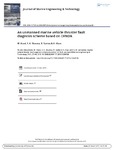Understanding Spatial Related Network Challenges from Physical and Network Layers
| dc.contributor.author | lim, C | |
| dc.contributor.author | goh, C | |
| dc.contributor.author | Khan, Asiya | |
| dc.contributor.author | li, Y | |
| dc.date.accessioned | 2017-06-19T08:45:02Z | |
| dc.date.available | 2017-06-19T08:45:02Z | |
| dc.date.issued | 2017-01-26 | |
| dc.identifier.isbn | 9781509045884 | |
| dc.identifier.issn | 2325-2626 | |
| dc.identifier.uri | http://hdl.handle.net/10026.1/9493 | |
| dc.description.abstract |
Wireless Sensor Network's communication reliability is greatly influenced by the spatial related network challenges found in the physical space between communicating nodes. In this paper, ZigBee based sensor nodes are experimented under the influence of two distinct spatial related network challenges (i) poor deployed environment and (ii) human movements. WSN parameters obtained are used to develop an ANFIS based model designed to predict these spatial related network challenges. Using ANFIS model prediction accuracies as performance indices, WSN parameters are analysed from the physical and network layers perspective. Physical layer's link properties, reception strength and reception variability, are shown to be key indicators to spatial related network challenges. The parameters observed are Mean RSSI, Average Coefficient of Variation RSSI, Neighbour Table Connectivity and Bi-directional Neighbour Table Connectivity. | |
| dc.format.extent | 368-373 | |
| dc.language.iso | en | |
| dc.publisher | IEEE | |
| dc.title | Understanding Spatial Related Network Challenges from Physical and Network Layers | |
| dc.type | conference | |
| dc.type | Conference Proceeding | |
| plymouth.author-url | https://www.webofscience.com/api/gateway?GWVersion=2&SrcApp=PARTNER_APP&SrcAuth=LinksAMR&KeyUT=WOS:000402039800066&DestLinkType=FullRecord&DestApp=ALL_WOS&UsrCustomerID=11bb513d99f797142bcfeffcc58ea008 | |
| plymouth.date-start | 2017-01-26 | |
| plymouth.date-finish | 2017-01-29 | |
| plymouth.conference-name | ICNC | |
| plymouth.publication-status | Published | |
| plymouth.journal | 2017 International Conference on Computing, Networking and Communications (ICNC) | |
| dc.identifier.doi | 10.1109/iccnc.2017.7876156 | |
| plymouth.organisational-group | /Plymouth | |
| plymouth.organisational-group | /Plymouth/Faculty of Science and Engineering | |
| plymouth.organisational-group | /Plymouth/Faculty of Science and Engineering/School of Engineering, Computing and Mathematics | |
| plymouth.organisational-group | /Plymouth/REF 2021 Researchers by UoA | |
| plymouth.organisational-group | /Plymouth/REF 2021 Researchers by UoA/UoA12 Engineering | |
| plymouth.organisational-group | /Plymouth/Users by role | |
| plymouth.organisational-group | /Plymouth/Users by role/Academics | |
| dc.publisher.place | Silicon Valley USA | |
| dcterms.dateAccepted | 2016-08-30 | |
| dc.rights.embargoperiod | Not known | |
| rioxxterms.versionofrecord | 10.1109/iccnc.2017.7876156 | |
| rioxxterms.licenseref.uri | http://www.rioxx.net/licenses/all-rights-reserved | |
| rioxxterms.licenseref.startdate | 2017-01-26 | |
| rioxxterms.type | Conference Paper/Proceeding/Abstract |


